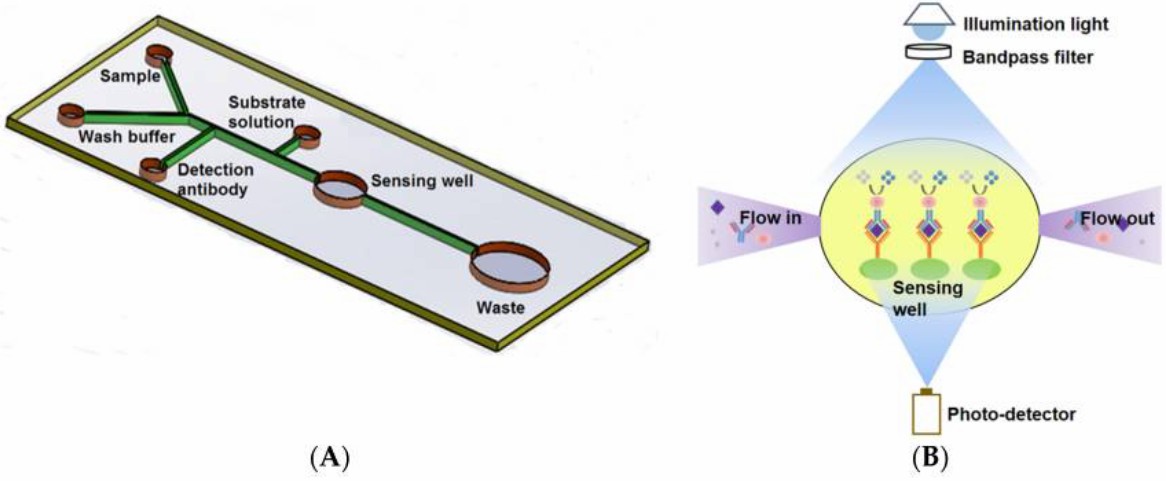Foodborne illnesses caused by food allergens are a common public health problem and have become a significant source of medical burden. Detection of allergens in food is a challenging task because they are usually present in trace amounts and are interfered with by the compounds that make up the food matrix. Traditional allergen detection methods are time-consuming, laborious, and often require skilled technicians. Microfluidics is a new technology that can precisely manipulate the very small amount of fluid (10-9-10-18 L) in submillimeter channels and is becoming increasingly popular in food safety monitoring methods. It is a powerful tool with many advantages, including smaller reagent volumes, shorter reaction times, shorter diffusion distances, smaller sizes, higher surface tensions, and higher sensitivity.
 Fig.1. Schematic of the Microfluidic ELISA chip layout. (Weng X, et al., 2016)
Fig.1. Schematic of the Microfluidic ELISA chip layout. (Weng X, et al., 2016)
Our scientists are investigating the development of microfluidics for food allergen detection. As a global allergen detection company, Lifeasible is committed to providing customers worldwide with microfluidic strategies for sample separation and rapid detection of food allergens. We have successfully developed fully integrated microfluidic platforms, including sample separation, allergen detection on a chip, system integration, and automation.
Lifeasible provides sample separation on microfluidic devices.
Microfluidic technology focuses on sample separation based on food allergens' physical and biological properties, such as size, polarizability, surface-specific receptors, affinity, etc. The concentration of allergens in complex food matrices (e.g., seafood, milk, peanuts, and shellfish) is low enough that we can use microfluidics to enrich target analytes (e.g., specific proteins or DNA) without any damage or modifications.
Lifeasible offers a variety of microfluidics-based technologies for the rapid detection of food allergens.
| Microfluidics-Based Technologies for Food Allergen Detection | Features of Microfluidics-Based Technologies |
| Immunoassays on a Chip | We combine microfluidics technology with immunosensors to enrich allergens from complex food matrices. This immunoassay platform can be easily scaled up to larger arrays using different colored beads conjugated to different antibodies for high throughput and multiplexed analysis of food allergens. |
| Nucleic Acid Analysis on a Chip | We combine microfluidic technology with genetic sensors to provide technical support for food allergen detection. This method is independent of protein phenotypic changes and is more thermally stable than most target protein-based methods. In addition, we can improve sensitivity by amplifying the copy number of the initial nucleic acid fragment. |
We have integrated biosensors on our microfluidic platform to detect multiple food allergens in parallel.
Lifeasible is committed to providing customers with the most appropriate microfluidic devices to detect allergens in food. We look forward to working with you, and you will benefit from our one-stop shop for everything from testing and reporting to the highest standards of post-analysis. If you are interested in our services, please feel free to contact us for more information.
Reference
Lifeasible has established a one-stop service platform for plants. In addition to obtaining customized solutions for plant genetic engineering, customers can also conduct follow-up analysis and research on plants through our analysis platform. The analytical services we provide include but are not limited to the following:
STU-CRISPR System Improves Plant Genome Editing Efficiency
April 19, 2024
Application of Exosomes in Facial Beauty
April 12, 2024